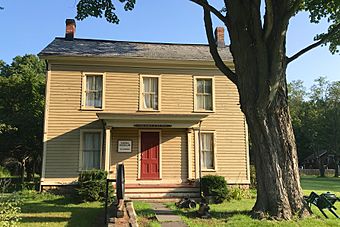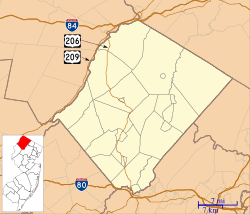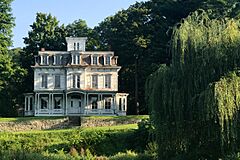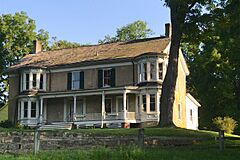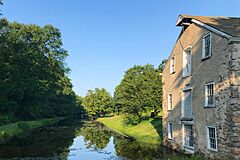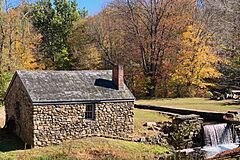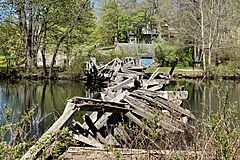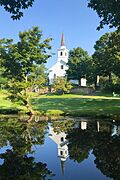Waterloo Village, New Jersey facts for kids
Waterloo Village is a special place in Byram Township, Sussex County, New Jersey. It's a restored 19th-century town that used to be a busy stop along the Morris Canal. Imagine a town where canal boats would stop to rest and resupply!
This historic village was about halfway on the 102-mile journey of the Morris Canal. The canal connected Jersey City to Phillipsburg, New Jersey. Waterloo had everything canal workers and their mules needed. There was an inn, a general store, a church, a blacksmith shop, and a watermill. It was the perfect place for an overnight stop.
Today, Waterloo Village is an open-air museum. It's part of Allamuchy Mountain State Park and is open to everyone from sunrise to sunset. The village was added to the National Register of Historic Places on September 13, 1977.
Contents
Welcome to Waterloo Village!
Waterloo Village offers a unique look into the past. It shows what life was like in a busy canal town during the 1800s. You can explore old buildings and learn about the people who lived and worked there.
A Busy Canal Town
The Morris Canal opened in 1831. It was mainly used to transport anthracite coal from Pennsylvania. The canal was busiest in the late 1860s, right after the American Civil War. At first, local railroads like the Lackawanna Railroad helped the canal. They didn't compete with it.
However, things changed. Trains were much faster and more reliable than canal boats. Canals would freeze in winter, making them unusable when coal was needed most. Because of this, the canal slowly lost its importance. Waterloo Village also became less busy. The canal was officially closed in 1924. By the time of the Great Depression, Waterloo Village was empty.
Unexpected Protectors
Even after the village was abandoned, it found new visitors. The Lackawanna Railroad ran close by. Freight trains would slow down near Waterloo because of a steep hill. This made it easy for travelers, sometimes called "hobos," to hop on and off the trains.
These travelers discovered Waterloo Village. They used it as a stopping point on their journeys toward New York. In a way, this was similar to its original purpose as a rest stop. These travelers actually helped protect the village by living there during the 1930s and 1940s. They kept the buildings from falling apart completely. The original Waterloo train station was even moved and became a private home in the 1940s.
Bringing the Village Back to Life
In 1967, a man named Percival 'Percy' Leach started a non-profit group. It was called the Waterloo Foundation for the Arts. His goal was to raise money to restore the village. Percy and his partner, Lou Gualandi, wanted to turn it into a living history attraction.
They brought in people who could show old crafts. You could see blacksmiths, potters, candle makers, and weavers at work. This helped visitors imagine what life was like long ago. Eventually, Waterloo Village became part of New Jersey's Allamuchy Mountain State Park.
Fun Events and Concerts
It cost a lot to keep the village running. So, in 1977, the partners opened an outdoor concert area. This helped raise money for the village's upkeep. Many famous musicians performed there over the years. These included Johnny Cash, The Beach Boys, Allman Brothers, Bob Dylan, and Neil Young.
Waterloo also hosted many other events. There were craft shows, cultural festivals, and even performances by the Metropolitan Opera. It was a place for jazz, classical music, and poetry festivals too.
New Beginnings and Activities
After a period of closure, different groups worked to restore parts of the village. The Friends of Waterloo and the Canal Society focused on the "Canal Town." Another non-profit, Winakung at Waterloo Inc., worked on the Lenape Indian Village.
Since 2014, group tours and programs have been available by reservation. Winakung at Waterloo Inc. offers educational programs. These are great for school trips, scout groups, and summer camps. They also offer programs for schools and libraries.
In 2014, a catering company, Jeffrey Miller Catering (JAM Catering), became the official caterer for Waterloo Village. They have updated the Meeting House and Pavilion. Also, since May 2014, the SMS Italian Festival, a yearly event supporting St. Michael School, has been held at the village. In May 2017, the old concert stage was taken down. This was to make way for new festivals and a new stage in the future.
The Village Church
The cornerstone for the Waterloo Village United Methodist Church was laid on August 9, 1859. The church was officially opened on February 9, 1860. General John Smith was the first person buried in the churchyard cemetery.
Images for kids
-
A small aqueduct crosses the old canal lock
See also


